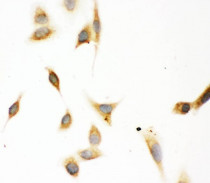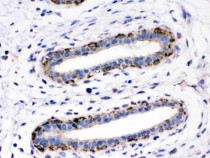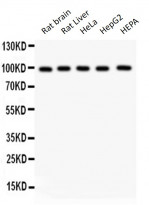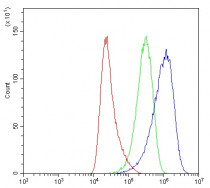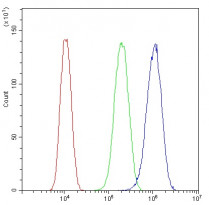ARG58312
anti-ASPH / Aspartate beta hydroxylase antibody
anti-ASPH / Aspartate beta hydroxylase antibody for Flow cytometry,ICC/IF,IHC-Formalin-fixed paraffin-embedded sections,Western blot and Human,Mouse,Rat
Overview
| Product Description | Rabbit Polyclonal antibody recognizes ASPH / Aspartate beta hydroxylase |
|---|---|
| Tested Reactivity | Hu, Ms, Rat |
| Predict Reactivity | Hm |
| Tested Application | FACS, ICC/IF, IHC-P, WB |
| Host | Rabbit |
| Clonality | Polyclonal |
| Isotype | IgG |
| Target Name | ASPH / Aspartate beta hydroxylase |
| Antigen Species | Human |
| Immunogen | Synthetic peptide corresponding to a sequence at the C-terminus of Human ASPH (726-758aa EVWQDASSFRLIFIVDVWHPELTPQQRRSLPAI), identical to the related Mouse sequence. |
| Conjugation | Un-conjugated |
| Alternate Names | EC 1.14.11.16; Peptide-aspartate beta-dioxygenase; JCTN; FDLAB; Aspartyl/asparaginyl beta-hydroxylase; AAH; CASQ2BP1; junctin; HAAH; Aspartate beta-hydroxylase; ASP beta-hydroxylase; BAH |
Application Instructions
| Application Suggestion |
|
||||||||||
|---|---|---|---|---|---|---|---|---|---|---|---|
| Application Note | IHC-P: Antigen Retrieval: By heat mediation. * The dilutions indicate recommended starting dilutions and the optimal dilutions or concentrations should be determined by the scientist. |
Properties
| Form | Liquid |
|---|---|
| Purification | Affinity purification with immunogen. |
| Buffer | 0.9% NaCl, 0.2% Na2HPO4, 0.05% Sodium azide and 5% BSA. |
| Preservative | 0.05% Sodium azide |
| Stabilizer | 5% BSA |
| Concentration | 0.5 mg/ml |
| Storage Instruction | For continuous use, store undiluted antibody at 2-8°C for up to a week. For long-term storage, aliquot and store at -20°C or below. Storage in frost free freezers is not recommended. Avoid repeated freeze/thaw cycles. Suggest spin the vial prior to opening. The antibody solution should be gently mixed before use. |
| Note | For laboratory research only, not for drug, diagnostic or other use. |
Bioinformation
| Database Links |
Swiss-port # Q12797 Human Aspartyl/asparaginyl beta-hydroxylase Swiss-port # Q8BSY0 Mouse Aspartyl/asparaginyl beta-hydroxylase |
|---|---|
| Gene Symbol | ASPH |
| Gene Full Name | aspartate beta-hydroxylase |
| Background | This gene is thought to play an important role in calcium homeostasis. The gene is expressed from two promoters and undergoes extensive alternative splicing. The encoded set of proteins share varying amounts of overlap near their N-termini but have substantial variations in their C-terminal domains resulting in distinct functional properties. The longest isoforms (a and f) include a C-terminal Aspartyl/Asparaginyl beta-hydroxylase domain that hydroxylates aspartic acid or asparagine residues in the epidermal growth factor (EGF)-like domains of some proteins, including protein C, coagulation factors VII, IX, and X, and the complement factors C1R and C1S. Other isoforms differ primarily in the C-terminal sequence and lack the hydroxylase domain, and some have been localized to the endoplasmic and sarcoplasmic reticulum. Some of these isoforms are found in complexes with calsequestrin, triadin, and the ryanodine receptor, and have been shown to regulate calcium release from the sarcoplasmic reticulum. Some isoforms have been implicated in metastasis. [provided by RefSeq, Sep 2009] |
| Function | Isoform 1: specifically hydroxylates an Asp or Asn residue in certain epidermal growth factor-like (EGF) domains of a number of proteins. Isoform 8: membrane-bound Ca(2+)-sensing protein, which is a structural component of the ER-plasma membrane junctions. Isoform 8 regulates the activity of Ca(+2) released-activated Ca(+2) (CRAC) channels in T-cells. [UniProt] |
| Cellular Localization | Isoform 1: Endoplasmic reticulum membrane; Single-pass type II membrane protein. [UniProt] |
| Calculated MW | 86 kDa |
Images (5) Click the Picture to Zoom In
-
ARG58312 anti-ASPH / Aspartate beta hydroxylase antibody ICC image
Immunocytochemistry: A549 cells were blocked with 10% goat serum and then stained with ARG58312 anti-ASPH / Aspartate beta hydroxylase antibody at 1 µg/ml dilution, overnight at 4°C.
-
ARG58312 anti-ASPH / Aspartate beta hydroxylase antibody IHC-P image
Immunohistochemistry: Paraffin-embedded Human mammary cancer stained with ARG58312 anti-ASPH / Aspartate beta hydroxylase antibody.
-
ARG58312 anti-ASPH / Aspartate beta hydroxylase antibody WB image
Western blot: 50 µg of Rat brain, 50 µg of Rat Liver, 40 µg of HeLa whole cell lysate, 40 µg of HepG2 whole cell lysate and 40 µg of HEPA whole cell lysate stained with ARG58312 anti-ASPH / Aspartate beta hydroxylase antibody at 0.5 µg/ml dilution.
-
ARG58312 anti-ASPH / Aspartate beta hydroxylase antibody FACS image
Flow Cytometry: HeLa cells were blocked with 10% normal goat serum and then stained with ARG58312 anti-ASPH / Aspartate beta hydroxylase antibody (blue) at 1 µg/10^6 cells for 30 min at 20°C, followed by incubation with DyLight®488 labelled secondary antibody. Isotype control antibody (green) was rabbit IgG (1 µg/10^6 cells) used under the same conditions. Unlabelled sample (red) was also used as a control.
-
ARG58312 anti-ASPH / Aspartate beta hydroxylase antibody FACS image
Flow Cytometry: U87 cells were blocked with 10% normal goat serum and then stained with ARG58312 anti-ASPH / Aspartate beta hydroxylase antibody (blue) at 1 µg/10^6 cells for 30 min at 20°C, followed by incubation with DyLight®488 labelled secondary antibody. Isotype control antibody (green) was rabbit IgG (1 µg/10^6 cells) used under the same conditions. Unlabelled sample (red) was also used as a control.
